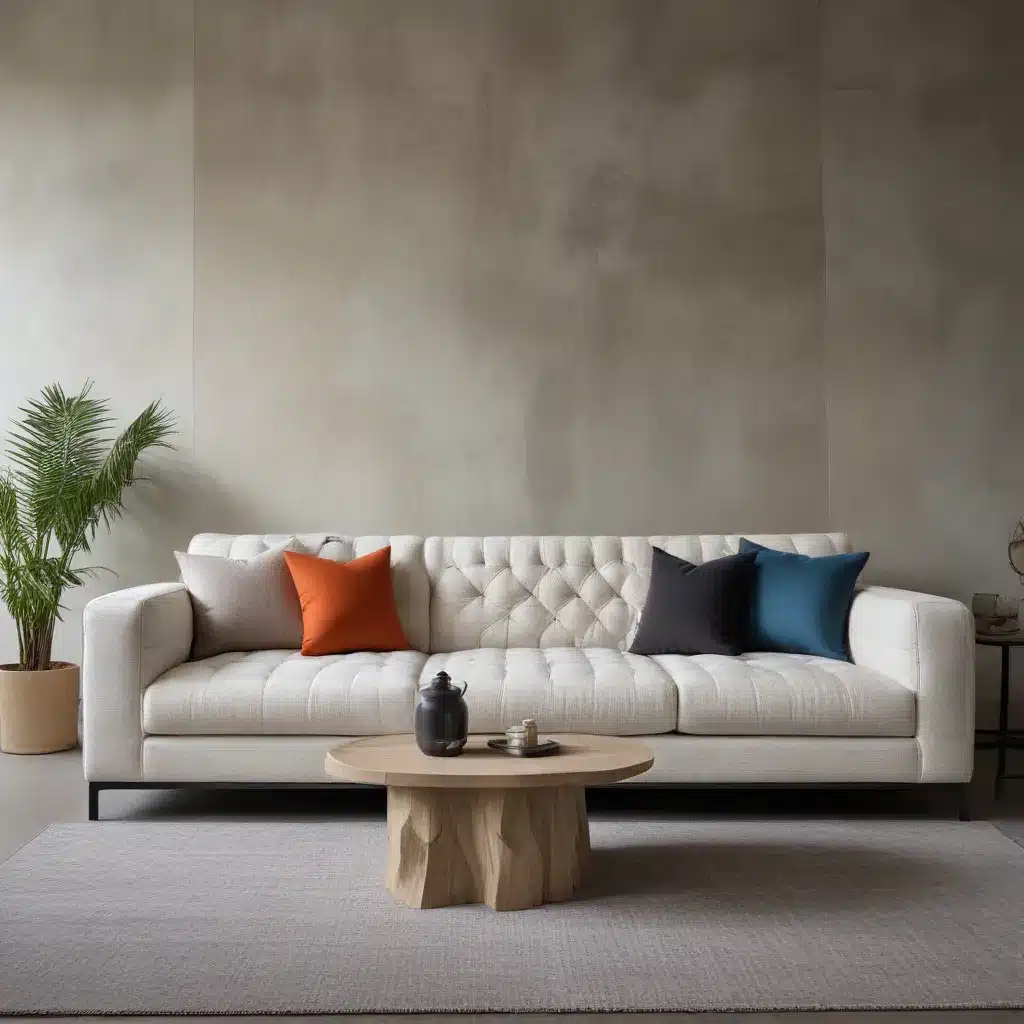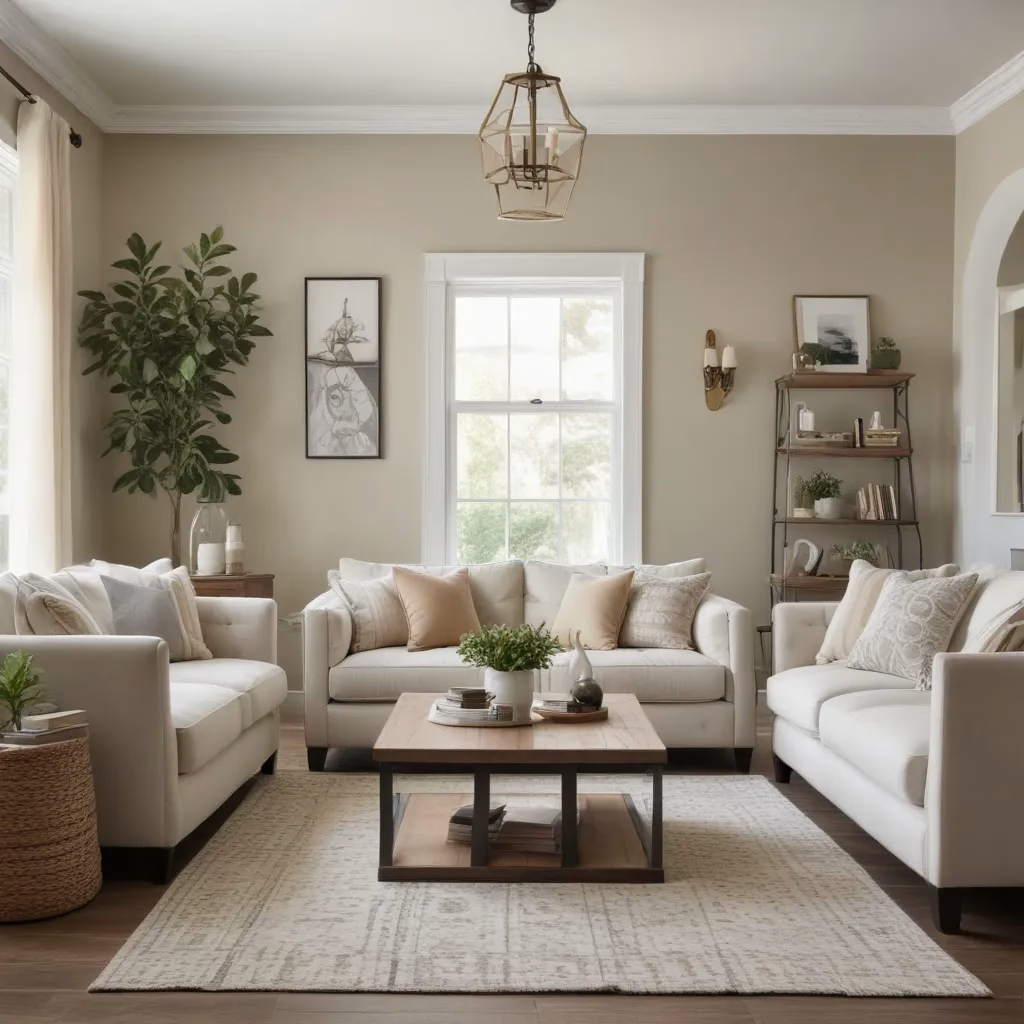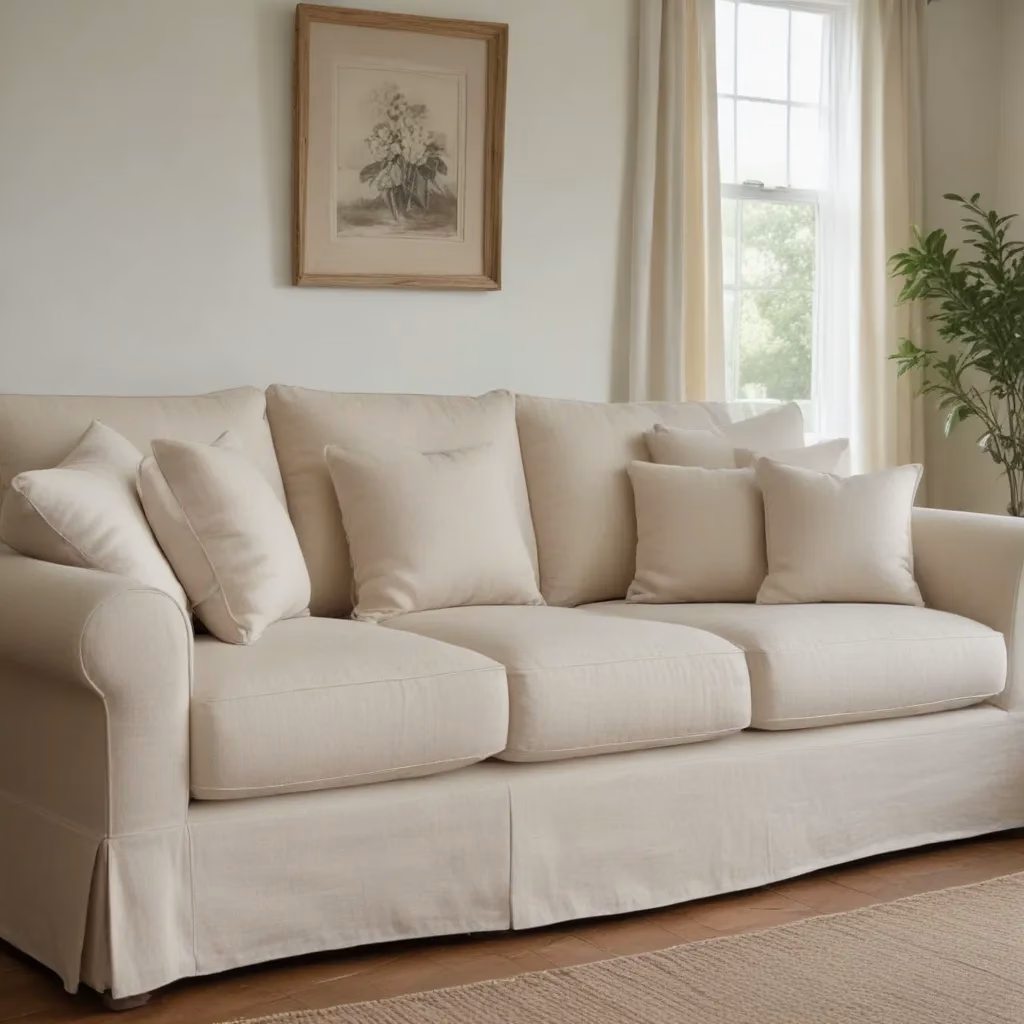
The Power of Texture in Sofa Design
When it comes to creating a truly inviting living space, the role of texture in sofa design cannot be overstated. As a furniture specialist with years of experience, I’ve seen firsthand how the right combination of textures can transform a room from mundane to magnificent. Texture isn’t just about how a sofa feels to the touch; it’s a visual and tactile element that adds depth, interest, and character to your living area.
In my work with clients, I’ve noticed that many homeowners underestimate the impact of textural contrasts. They often focus solely on color and pattern, missing out on the rich possibilities that varying textures can bring to their space. But when you introduce a mix of smooth, rough, plush, and sleek surfaces, you create a multi-dimensional environment that engages the senses and draws people in.
Let’s consider a classic example: a leather sofa paired with a chunky knit throw. The smooth, cool surface of the leather creates a beautiful juxtaposition against the warm, tactile nature of the knitted fabric. This contrast not only looks visually appealing but also invites touch, making the space feel more welcoming and lived-in. It’s these thoughtful combinations that can elevate your sofa from a simple piece of furniture to the centerpiece of your room.
Understanding Different Sofa Textures
When we talk about sofa textures, we’re exploring a wide range of possibilities. Each texture brings its own unique qualities to your space, influencing both the look and feel of your room. Let’s break down some of the most popular sofa textures I’ve worked with:
-
Velvet: Luxurious and soft, velvet adds a touch of glamour to any room. Its plush surface reflects light in a way that can make colors appear richer and deeper. I often recommend velvet for clients looking to create a cozy, opulent atmosphere.
-
Leather: Durable and sleek, leather sofas offer a timeless appeal. They’re perfect for creating a sophisticated, modern look. Plus, genuine leather develops a beautiful patina over time, adding character to your space.
-
Linen: Light and airy, linen gives a relaxed, casual vibe. It’s great for creating a breezy, coastal feel in your living room. However, it wrinkles easily, which some find adds to its charm, while others prefer a crisper look.
-
Wool: Warm and textured, wool upholstery is perfect for creating a cozy, inviting space. It’s naturally resistant to staining and wrinkling, making it a practical choice for busy households.
-
Microfiber: This synthetic fabric is known for its durability and ease of cleaning. It has a soft, suede-like texture that’s pleasant to the touch and comes in a wide range of colors.
When selecting a sofa texture, it’s crucial to consider not just the appearance, but also the practicality. For instance, while I love the look of a crisp white linen sofa, I might steer clients with young children or pets towards more forgiving options like leather or microfiber. The key is finding a balance between aesthetics and functionality that works for your lifestyle.
Mixing Textures for Visual Interest
One of the most exciting aspects of my job is helping clients mix and match textures to create visually stunning living spaces. The art of combining different textures is what truly brings a room to life. It’s not just about throwing together random textures; there’s a method to creating a harmonious blend that pleases the eye and invites touch.
Here are some tried-and-true combinations I often recommend:
-
Smooth with Rough: Pairing a smooth leather sofa with a rough jute rug creates a beautiful contrast. The sleek surface of the leather plays off the natural, earthy texture of the jute, creating a balanced look that’s both sophisticated and grounded.
-
Plush with Sleek: A velvet sofa paired with glass or metal side tables is a classic combination. The softness of the velvet contrasts beautifully with the hard, reflective surfaces of the tables, creating a luxurious yet modern aesthetic.
-
Matte with Shiny: Consider a matte linen sofa accented with shiny silk throw pillows. This combination adds depth and interest to your space, with the light playing differently off each surface.
When mixing textures, I always advise my clients to consider the overall feel they want to achieve in their space. Are you going for cozy and inviting? Sleek and modern? Eclectic and vibrant? The textures you choose can significantly influence the atmosphere of your room.
Remember, too, that texture isn’t limited to just the sofa and its accessories. The walls, flooring, and other furniture pieces all contribute to the textural landscape of your room. A textured wallpaper behind a smooth leather sofa, for instance, can create a stunning focal point in your living room.
The Role of Color in Textural Contrasts
While we’re focusing on texture, it’s important to note that color plays a crucial role in how we perceive texture. The interplay between color and texture can either enhance or diminish the impact of your textural choices.
In my experience, neutral colors often allow textures to shine more prominently. A cream-colored bouclé sofa, for example, showcases the nubby texture of the fabric beautifully. The lack of bold color allows your eye to focus on the tactile qualities of the material.
On the other hand, rich, deep colors can add another layer of depth to textured fabrics. A deep blue velvet sofa, for instance, not only feels luxurious to the touch but also has a visual depth that draws you in. The color enhances the plush texture, making the sofa appear even more inviting.
When working with textural contrasts, I often advise clients to consider a color palette that complements their textural choices. If you’re mixing several bold textures, you might want to stick to a more subdued color scheme to avoid overwhelming the space. Conversely, if you’re working with subtler textures, you have more freedom to play with bolder colors.
Remember, the goal is to create a harmonious balance that’s pleasing to both the eye and the touch. It’s this thoughtful combination of texture and color that can truly elevate your sofa from a simple piece of furniture to a stunning focal point in your living space.
Practical Considerations for Textured Sofas
While the aesthetic appeal of textured sofas is undeniable, it’s crucial to consider the practical aspects of your choice. As someone who’s helped countless clients navigate these decisions, I can tell you that the most beautiful sofa in the world won’t bring you joy if it doesn’t suit your lifestyle.
Here are some key factors to consider:
-
Durability: Some textures are more durable than others. Leather, for instance, is known for its longevity and ability to withstand wear and tear. On the other hand, delicate fabrics like silk might not be the best choice for a household with children or pets.
-
Maintenance: Different textures require different levels of care. Velvet, while beautiful, can be tricky to clean and may show marks easily. Microfiber, in contrast, is relatively low-maintenance and easy to clean.
-
Comfort: The texture of your sofa will significantly impact how comfortable it is to sit on. A nubby tweed might look great, but if you find it scratchy, you’re less likely to enjoy lounging on your sofa.
-
Allergies: If anyone in your household has allergies, you’ll want to consider textures that don’t trap dust and allergens. Leather and tightly woven fabrics are often good choices for allergy sufferers.
-
Climate: Believe it or not, your local climate can influence your texture choices. In hot, humid climates, you might want to avoid textures that feel sticky or hot against the skin, like certain types of leather or heavy fabrics.
I always encourage my clients to test out different textures before making a final decision. Sit on the sofa, run your hand over the fabric, and imagine living with it day in and day out. A sofa is a significant investment, and you want to ensure it’s not just beautiful, but also practical for your lifestyle.
Accessorizing Your Textured Sofa
Once you’ve chosen your perfect textured sofa, the fun really begins with accessorizing. This is where you can truly let your personality shine and create a cohesive look in your living space. The right accessories can enhance your sofa’s texture, create additional contrasts, and tie your whole room together.
Here are some of my favorite ways to accessorize a textured sofa:
-
Throw Pillows: These are a great way to introduce complementary or contrasting textures. On a smooth leather sofa, I love adding pillows in chunky knits or plush velvets. For a nubby tweed sofa, silky or smooth pillows can provide a beautiful contrast.
-
Throws: A well-placed throw can add both texture and color to your sofa. A faux fur throw on a linen sofa, for example, creates a cozy, inviting look perfect for chilly evenings.
-
Area Rugs: While not directly on the sofa, an area rug can complement or contrast with your sofa’s texture. A shaggy rug paired with a sleek leather sofa creates an interesting textural interplay.
-
Wall Art: Consider the texture of your wall decor. A rough, textured painting or tapestry can beautifully offset a smooth sofa texture.
-
Plants: Greenery adds a natural texture that complements almost any sofa. The organic shapes and textures of plants can soften the lines of your furniture and add life to your space.
Remember, the key to successful accessorizing is balance. You don’t want to overwhelm your space with too many competing textures. Instead, aim for a harmonious blend that enhances your sofa and creates a cohesive look in your room.
When accessorizing, I always advise my clients to step back and look at the room as a whole. Does each element contribute to the overall aesthetic you’re aiming for? Does the room feel balanced and inviting? Don’t be afraid to experiment and rearrange until you find the perfect combination.
The Future of Textured Sofas
As we look to the future of sofa design, texture continues to play a pivotal role. I’ve been keeping a close eye on emerging trends, and I’m excited about the innovative approaches designers are taking to incorporate texture into their creations.
One trend I’m particularly enthusiastic about is the use of sustainable, eco-friendly materials that bring unique textures to sofas. Fabrics made from recycled plastics, for instance, not only contribute to environmental conservation but also offer interesting textural possibilities. These materials can mimic the feel of traditional fabrics while providing enhanced durability and easy maintenance.
Another exciting development is the rise of modular sofas with interchangeable covers. This allows homeowners to switch up their sofa’s texture seasonally or as their tastes change. Imagine having a cozy, nubby texture for winter that you can swap out for a cool, smooth linen in summer. This flexibility is perfect for those who love to refresh their living spaces regularly.
Technology is also playing a role in the future of textured sofas. Smart fabrics that can change texture or warmth based on body temperature are in development. While still in the early stages, these innovations could revolutionize how we think about comfort and functionality in sofa design.
As we move forward, I believe we’ll see an even greater emphasis on tactile experiences in home design. In our increasingly digital world, there’s a growing appreciation for physical textures that engage our senses and create a connection to our living spaces. Textured sofas are at the forefront of this movement, offering a tangible way to create depth, interest, and comfort in our homes.
Caring for Your Textured Sofa
Proper care and maintenance are crucial for preserving the beauty and longevity of your textured sofa. Each texture requires a different approach to cleaning and upkeep, and as someone who’s dealt with countless sofas over the years, I can’t stress enough how important it is to follow the manufacturer’s care instructions.
Here are some general tips for caring for different sofa textures:
-
Leather: Wipe down regularly with a soft, dry cloth. For deeper cleaning, use a leather cleaner and conditioner to maintain the material’s suppleness. Avoid placing leather sofas in direct sunlight to prevent fading and cracking.
-
Velvet: Use a soft brush attachment to vacuum regularly, always brushing in the direction of the pile. For spills, blot immediately with a clean, dry cloth. Avoid rubbing, as this can damage the pile.
-
Linen: Vacuum regularly using a soft brush attachment. For stains, blot immediately and clean with a mild soap solution. Avoid over-wetting the fabric, as linen can shrink.
-
Microfiber: Most spills can be cleaned with a bit of water and mild soap. For tougher stains, a solution of rubbing alcohol and water can be effective. Always test cleaning solutions on an inconspicuous area first.
-
Wool: Vacuum regularly to remove dust and debris. For spills, blot immediately and clean with a wool-safe detergent. Avoid scrubbing, as this can damage the fibers.
Remember, prevention is always better than cure. Use arm covers and throws to protect high-wear areas, and consider applying a fabric protector to guard against stains. Regular maintenance will keep your textured sofa looking its best for years to come.
Making the Right Choice for Your Home
Choosing the perfect textured sofa for your home is a personal decision that depends on various factors. As a furniture specialist, I always encourage my clients to consider their lifestyle, aesthetic preferences, and practical needs when making this important choice.
Start by assessing your living habits. Do you have children or pets? Do you entertain frequently? These factors will influence the type of texture that’s most suitable for your sofa. A household with kids and pets might benefit from a durable, easy-to-clean texture like leather or microfiber, while a formal living room might be better suited to a luxurious velvet or silk blend.
Consider the overall style of your home as well. A rustic, farmhouse-style interior might pair well with a nubby linen or tweed texture, while a sleek, modern space could be complemented by a smooth leather or tightly woven fabric.
Don’t forget about comfort. While aesthetics are important, your sofa should also be a place where you can relax and unwind. Take the time to sit on different textured sofas and see which feels most comfortable to you.
Ultimately, the right textured sofa for your home is one that balances beauty, comfort, and practicality. It should be a piece that you love to look at, love to touch, and love to live with day after day.
If you’re feeling overwhelmed by the choices, don’t hesitate to seek professional advice. At Sofa Spectacular, we’re always happy to help you navigate the world of textured sofas and find the perfect fit for your home. Remember, a well-chosen sofa is more than just a piece of furniture – it’s the heart of your living space, where memories are made and life happens.



